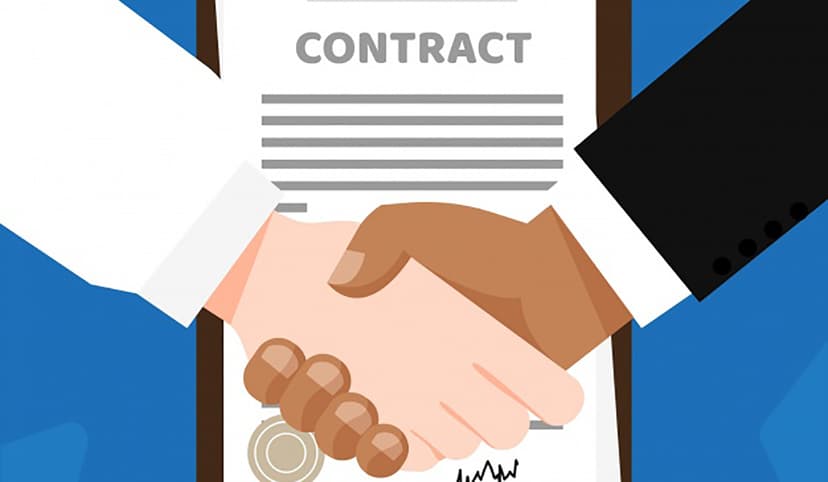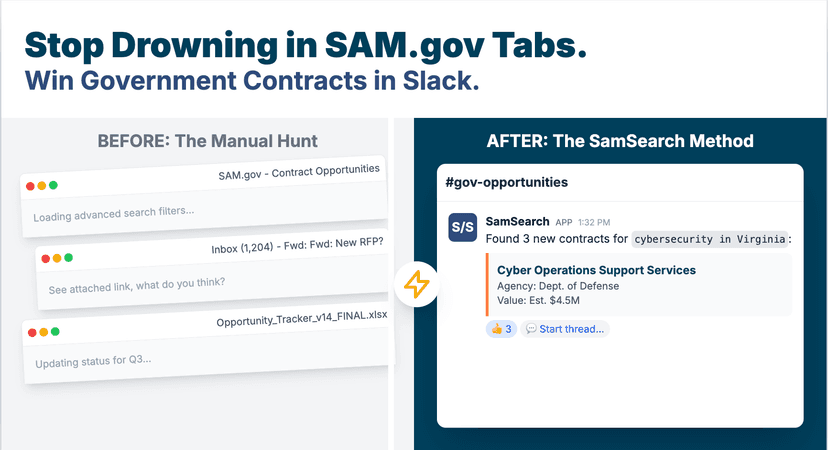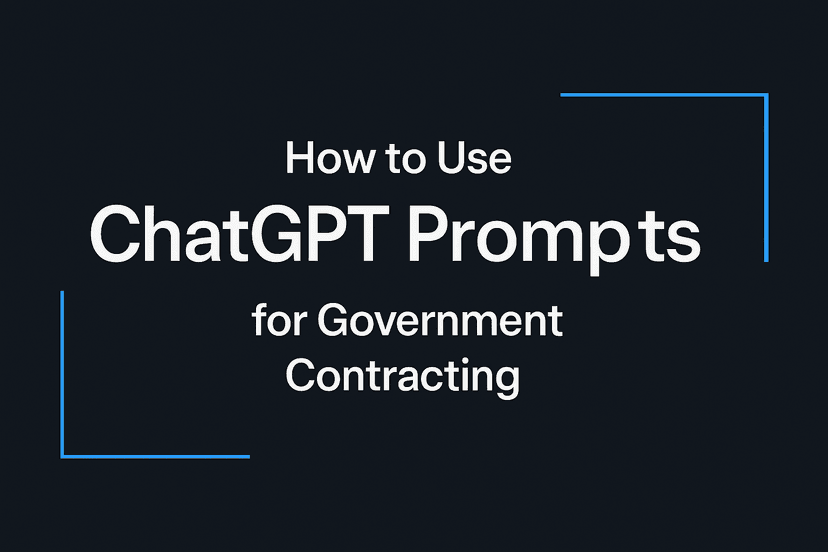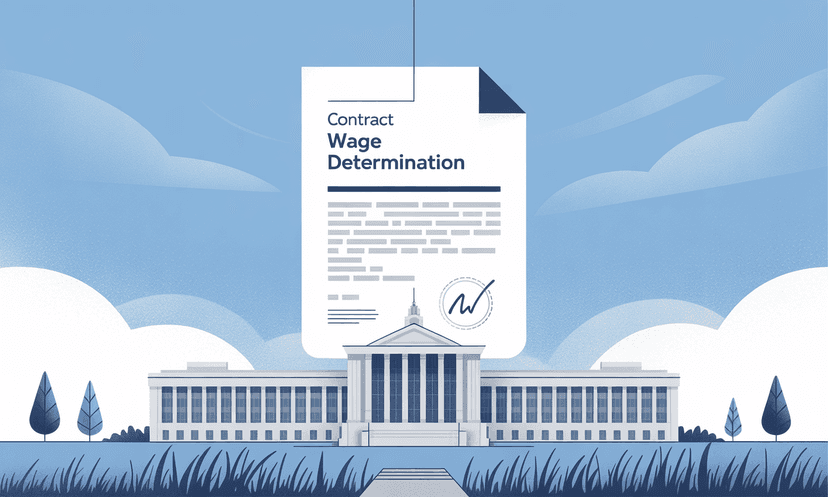How to Win Government Construction Contracts (Federal, State & Local) – A Step-by-Step Guide
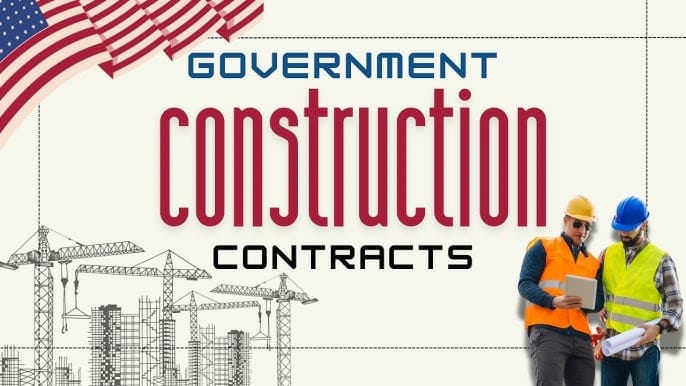
A complete guide of how you can win construction government contracts.
🎥 Prefer video? Watch the full breakdown here:
1. Overview of Government Construction Contracts
Government agencies at all levels (federal, state, local) spend hundreds of billions of dollars on construction projects every year. These projects span infrastructure (roads, bridges, utilities), vertical construction (buildings like schools, hospitals, offices), and specialty projects (water treatment plants, runways, etc.). In 2023, U.S. public construction spending was about $451 billion (Value of public construction in the U.S. 1999-2023 - Statista), demonstrating the huge scope of this market. At the federal level alone, “Facilities & Construction” contracts accounted for roughly $132 billion (≈17% of all federal contracting) in FY2024. This means there is a vast opportunity for construction firms of all sizes – from small local contractors to large national builders – to win government work.
Despite the scale, the government contracting arena is structured to be accessible to newcomers. By law, a portion of federal contracts are set aside for small businesses, and in recent years over a quarter of federal contract dollars have gone to small firms (Small business government contracting hits record high of $163B, SBA says | FedScoop). State and local governments likewise often encourage participation from local and small contractors. The key is understanding how to get started and navigate the process. This guide will walk you through the steps: from registering as a contractor, to finding opportunities and bidding, to building your track record. We’ll cover all three levels of government, so you can see the differences and commonalities. By the end, you should have a clear roadmap to competing for (and winning) government construction contracts – and we’ll suggest some tools (like the SamSearch platform you plan to demo) to make the journey easier.
How this guide is organized: We’ll start with the basics of registration and compliance (to ensure you’re eligible to bid), then move into how to find contract opportunities and prepare bids. We’ll also discuss strategies for new contractors to gain experience, and highlight tips and pitfalls. Throughout, we’ll use simple language and break things down step-by-step.
2. Registering as a Government Contractor
Before you can bid on or win a government contract, you must complete some registrations and certifications. Think of this as setting up your “license to operate” in the government market. Here are the main steps:
-
Register Your Business in SAM.gov (Federal Registration): For federal contracts, you need to register in the System for Award Management (SAM) database. This is the official government vendor registry. When you register, you’ll obtain a Unique Entity ID (UEI) for your business (as of 2022, the UEI replaced the old DUNS number system (Unique Entity Identifier update | GSA)). SAM registration requires basic info about your company (legal name, address, EIN/tax ID, etc.), your banking info (for payments), and a list of your NAICS codes – the industry classification codes that describe what you do (e.g. 236220 for Commercial Building Construction, etc.) (Complete Guide to NAICS Codes: Understanding Industry Classifications and Their Business Applications). You will also enter your company’s size (to determine if you qualify as a small business) and complete the online Representations and Certifications section, which is a set of affirmations about following federal regulations.
-
Obtain Required Codes and IDs: As mentioned, you’ll need an Employer Identification Number (EIN) (from the IRS) and you’ll automatically get a UEI through SAM. Identify your relevant NAICS codes beforehand – you can have multiple, covering all the types of work you can perform. Picking the right NAICS codes is important; it affects how agencies find you in SAM and what contracts you are eligible for. (For example, if you do residential construction and minor civil work, you might list NAICS codes for both building construction and highway/street construction.)
-
Pursue Small Business Certifications (if eligible): The U.S. Small Business Administration (SBA) offers programs that certify certain businesses for special set-aside contracts. Many government construction projects are reserved for specific types of small businesses, so these certifications can give you a competitive edge (Government Construction Bids 101: What You Need to Know - Bonfire). Notable certifications include: 8(a) Small Disadvantaged Business (for socially and economically disadvantaged owners), HUBZone (for businesses in Historically Underutilized Business Zones), WOSB/EDWOSB (Women-Owned Small Business), and SDVOSB (Service-Disabled Veteran-Owned Small Business). Each has an application process (through SBA’s website) and eligibility criteria. If you qualify, getting certified can open doors – some contracts are sole-sourced or competed only among those certified groups. Tip: also check your state and local governments for similar programs (many cities have local MBE/WBE programs, etc.).
-
Register in State and Local Vendor Systems: State governments and many city/county governments have their own vendor registration portals. While not as standardized as SAM, you typically must create an account in their systems to bid on opportunities or to get notified of projects. For example, a state might require you to register your business in a procurement database and select commodity codes (similar to NAICS) for the goods/services you provide. Action item: Identify the procurement website for each state or city you plan to work in and register your firm there. (E.g., Texas uses the Electronic State Business Daily (ESBD) for state agency bids, California uses Cal eProcure, New York has the NY Contract Reporter, etc.) Make sure to also obtain any contractor licenses required by that state for your trade (many states require a general contractor’s license or specialty licenses for electrical, plumbing, etc., to perform construction).
-
Prepare a Capability Statement: While not a registration, it’s highly recommended you create a one-page Capability Statement for your company. This document summarizes who you are, what you do, past projects (if any), NAICS codes, certifications, and contact info. Agencies and primes may ask for this in early conversations. It’s essentially your business resume for government work. Having a polished capability statement will make you look professional and ready.
Completing registrations can be a bit tedious – SAM.gov, for instance, has several sections to fill out – but it’s a one-time (annual) effort that unlocks the entire marketplace. Take your time to do it accurately (mistakes in your SAM profile can cause issues; e.g., banking info errors could delay payments). Once registered, you’re officially eligible to bid on federal contracts and you’ll appear in the government database that contracting officers review. One more tip: after registering in SAM, also update your Dynamic Small Business Search (DSBS) profile via SBA’s site. This is what federal small business specialists use to find potential contractors, and you can input a narrative about your company and past projects there.
3. Meeting Compliance Requirements (Licenses, Bonds, Insurance, Labor Rules)
Registering is just one side of being contract-ready. Construction contracts, in particular, come with additional compliance requirements that you must be prepared for. These ensure that any contractor who wins a government project has the financial and legal ability to complete it. Newcomers should familiarize themselves with the following:
-
Contractor Licensing: Ensure you have the appropriate contractor’s license for the jurisdiction of the project. For example, many states require construction contractors (especially general contractors on large jobs) to hold a state-issued license. Local governments might require a local business license or building contractor permit as well. Research the requirements of the project location and get licensed/bonded as required by state law (this is separate from contract-specific bonds discussed next).
-
Surety Bonds (Bid, Performance, Payment): Public construction projects almost always require surety bonds as a financial guarantee. A Bid Bond is often required when you submit a bid (especially for federal and state projects) – it assures that you will accept the contract and post performance bonds if you win, or else the bond pays a penalty. More importantly, Performance and Payment Bonds are required from the winning contractor for most substantial projects. Under the federal Miller Act, any federal construction contract over $150,000 requires performance and payment bonds (Bond Thresholds Now $150k!) (these protect the government by guaranteeing you will perform the work and pay your subcontractors and suppliers). States have analogous “Little Miller Acts” with their own thresholds (often for contracts above $50,000 or $100,000, varying by state). This means you will need to have a relationship with a surety company (bonding company) and demonstrate the financial capacity to get bonds. As a new small contractor, getting bonded for the first time can be a challenge – the surety will evaluate your credit, experience, and finances. The good news is the SBA has a Surety Bond Guarantee Program to help small businesses obtain bonds: the SBA will guarantee a large percentage of the bond amount, encouraging surety companies to issue bonds to firms that might not otherwise qualify (Surety bonds | U.S. Small Business Administration). If you anticipate bidding on bonded projects, engage a surety agent early, determine your bonding limit (how large a project you can bond), and have at least a bid bond lined up. Failure to furnish required bonds after an award can lead to losing the contract, so this is critical.
-
Insurance Requirements: Along with bonds, government contracts specify certain insurance coverage you must carry. Common requirements include General Liability insurance (with specified minimum coverage, e.g. $1 million per incident), Workers’ Compensation insurance (mandated by law if you have employees), and often Builder’s Risk insurance for the construction project itself. Some contracts may require Automobile Liability (for any vehicles used) or specialty policies if the work is high-risk. Before bidding, review the solicitation’s insurance clause so you know what’s needed. Have an insurance agent ready to provide a Certificate of Insurance naming the government as additional insured once you win. Insurance costs should be factored into your bid pricing.
-
Prevailing Wage Laws (e.g. Davis-Bacon Act): Labor compliance is a big deal in public construction. Most government-funded construction projects require you to pay workers prevailing wages, which are specific wage rates set for each trade in the project’s location. At the federal level, the Davis-Bacon Act applies to any federally-funded construction contract over $2,000 – it mandates that you pay at least the locally prevailing wage (plus fringe benefits) to all laborers and mechanics on the job (Government Construction Bids 101: What You Need to Know - Bonfire). In practice, the Department of Labor issues a wage determination for the project that lists the minimum hourly wage you must pay each type of worker (carpenter, electrician, equipment operator, etc.). You’ll also need to submit weekly certified payroll reports to the government to prove compliance. Many state and local governments have their own prevailing wage or “living wage” ordinances as well (often called “Little Davis-Bacon” laws). Non-compliance can result in serious penalties or payment withholding. So, understand the wage requirements and include those labor rates in your cost estimates. If you’re not used to paying those rates (they might be higher than standard), you must adjust your bid accordingly.
-
Safety and Regulatory Compliance: Government contracts will hold you to high standards for safety and regulatory compliance. Expect to comply with OSHA safety regulations at a minimum. On federal projects, you may need to submit a site-specific safety plan or have an EMR (Experience Modification Rate for insurance) within a certain range. Environmental rules (like managing dust, stormwater runoff from your site, proper disposal of hazardous materials) will be outlined in the specs. Make sure you can meet these, and that your team is trained and briefed. Being a responsible contractor in the government’s eyes means no serious safety violations or legal troubles.
-
Understanding the Contracting Rules: When doing federal work, you are subject to the Federal Acquisition Regulation (FAR) and agency-specific supplements. These contain numerous clauses you must follow (for example, rules about equal employment opportunity, affirmative action, Buy American Act material sourcing, etc., are often in the contract). While you don’t need to memorize the FAR, be aware that when you sign a government contract, you’re agreeing to a lot of contractual clauses. Read the contract or at least the list of FAR clauses in the solicitation (often found in Section I of a federal RFP) to avoid surprises. If something like a mandatory project labor agreement or special security clearance is required, it will be stated.
In summary, ensure your company is “compliance-ready”. This instills confidence in government buyers that you can handle the responsibility of a public contract. Practical steps to take before bidding include: lining up a bond facility, confirming you have the needed licenses, talking to your insurance broker about coverage costs, and educating yourself on labor wage requirements. It’s better to address these upfront than to scramble post-award. Having these ducks in a row sets you apart as a prepared bidder.
4. Finding Contract Opportunities
Once you’re registered and know the rules of the road, the next step is finding actual contract opportunities to bid on. Government construction projects are publicly advertised – you just need to know where to look. We’ll break this down by level of government:
-
Federal Opportunities (SAM.gov): The primary portal for federal government procurements is SAM.gov (specifically the Contract Opportunities section). All federal agencies publish their solicitations here (for contracts above $25,000, it’s mandatory). SAM.gov is free and open to the public – anyone can search it without even logging in (Contract Opportunities | SAM.gov). You can start by going to SAM.gov and using the search filters to find construction projects. For example, you can filter by NAICS code (e.g. 236220 or 237310), by location/state, by agency (Army Corps of Engineers, GSA, etc.), by keywords (“roof replacement” or “parking lot repair”), and by set-aside type (if you only want small-business or 8(a) opportunities). If you create a free login, you can also save searches and get email alerts when new opportunities match your criteria. Federal postings on SAM.gov will typically be labeled as Sources Sought, Pre-Solicitation, Solicitation (IFB/RFP), etc. Focus on actual solicitations (IFB/RFP/RFQ) for bidding. Each listing will have downloadable solicitation documents (plans, specs, etc.) and a point of contact. Suggestion: In your video, show a quick demo of SAM.gov’s search – e.g. search for “NAICS 236220” and how to navigate an opportunity listing. This visual can demystify the process for viewers.
-
State Government Opportunities: Every state has its own procurement system. Many states centralize their contract opportunities on a statewide portal. For example, Texas’s Electronic State Business Daily (ESBD) lists all Texas state agency construction bids; California uses an online system called Cal eProcure where you can search state contracts; Florida has the Vendor Bid System (VBS), and so on. Some states might use third-party platforms (like Jaggaer, SciQuest, or BidSync) to host their opportunities. The best approach is to visit the official state procurement website or search “[Your State] procurement bids construction”. Once there, use their search or filter functions to find construction projects. You may need to register an account to download documents or to be added to the bidders list (many states allow you to view postings publicly but require login to actually bid). Also, check State Department of Transportation (DOT) websites – DOTs often have separate portals for highway contracts and may even publish a regular advertisement bulletin. For instance, if you’re interested in roadwork, finding the DOT bid schedule for your state is key. Action item: Make a list of target states and ensure you’re signed up in each system. Then regularly check or subscribe to notifications for new construction RFPs/IFBs.
-
Local (County/City) Opportunities: Local governments – counties, cities, school districts, special districts – collectively issue thousands of smaller construction contracts (and some big ones like city airports or stadiums). These can be a great entry point for newcomers because the projects are often smaller and competition may be less intense than federal jobs. To find them, go to the specific agency’s website (e.g. City of Atlanta Procurement Department, or Cook County Illinois contracting site) and look for “Bids/RFPs” section. Many cities publish invitations for bids on their site or in local newspapers. Some larger cities use online bidding portals similar to states. Additionally, there are regional platforms – for example, BidNet is a service that many local agencies across multiple states use to post bids (if you register on BidNet, you can see a consolidated feed of participating local gov’t bids). Another method: APEX Accelerators (formerly known as PTACs – Procurement Technical Assistance Centers) often maintain lists or will alert local businesses about city/county opportunities. You can contact your nearest APEX Accelerator and ask about local bid leads (Contract Opportunities | SAM.gov). Don’t overlook local school districts, public housing authorities, and transportation authorities – they also have construction and maintenance contracts (often posted on their respective websites or the state’s site).
-
Tracking and Notifications: Given the fragmented nature of state/local postings, it can be time-consuming to manually visit dozens of websites. This is where using an aggregator tool or setting up notifications is valuable. You can subscribe to email alerts on many state portals by selecting commodity codes of interest. There are also commercial services that aggregate bid opportunities from various government levels into one dashboard (some paid, some free). Since you have an AI platform (SamSearch) in development, you likely plan to address this pain point by aggregating and searching across multiple sources – a great value proposition to mention. For now, for a newcomer, I’d recommend at minimum setting up a routine to check SAM.gov and your state/local sites weekly, or use free RSS feeds/alerts if available. Persistence is key: new opportunities pop up daily.
-
Opportunity Forecasts: One more tip for finding leads – many agencies publish forecast reports or annual plans of upcoming projects. For instance, the federal government has agency forecast sites (the GSA hosts a consolidated forecast tool (GSA: Home)). These forecasts can tell you about major projects coming down the pipeline (e.g. a state DOT might say they plan to bid a big highway interchange in Q4). By reviewing forecasts, you can be prepared in advance (team up or get finances in order) for a future project. This is more long-term, but worth keeping an eye on once you’re actively in the market.
In short, go where the bids are: SAM.gov for federal, state portals for state agencies, and individual local entity websites for city/county projects. It might sound like a lot of ground to cover, but start with one or two sources most relevant to you and expand from there. As you become familiar with the process, you’ll develop a sense of which agencies have the kind of work you want (for example, if you do building renovations, you might focus on school districts and the General Services Administration; if you do road paving, focus on state DOT and city public works departments).
(Visual suggestion: consider showing a screen capture of a SAM.gov search results page for a construction keyword, and perhaps a snapshot of a state procurement website with a list of construction bids. You could also show a map highlighting different levels of government to illustrate that opportunities exist at each level.)
5. Analyzing RFPs/IFBs and Preparing a Strong Bid
So you’ve found a project you want to bid – congratulations! Now the real work begins: preparing your bid or proposal. This step can be the most time-consuming, but a methodical approach will improve your chances of winning. Let’s break down the process of analyzing the solicitation and crafting your response:
(Architects Reviewing Construction Blueprints Outdoors · Free Stock Photo) Figure: Builders reviewing blueprints to plan their bid.
-
Read the solicitation carefully (and multiple times): Government RFPs/IFBs are typically lengthy documents (often well over 100 pages for construction, including drawings and specifications) (3 Pitfalls to Avoid When Bidding on Government Contracts) and are bound by strict regulations and detailed requirements (Government Construction Bids 101: What You Need to Know - Bonfire). The first thing to do is download ALL the files attached to the opportunity – usually this includes the main RFP/IFB document, technical specifications, drawings or plans, and sometimes attachments (like wage determinations or soil reports). Skim through the documents to get the big picture, then read them in detail. Pay special attention to:
- Scope of Work: What exactly is the project? (e.g. “Construct a 10,000 sq ft administrative building with parking and landscaping”). This might be described in the spec or an SOW section.
- Deadline and Timeline: Note when the bid is due (deadline for submission) and any schedule requirements (e.g. “project to be completed within 180 days of award” or specific milestone dates).
- Proposal/Bid Instructions: In a federal RFP, Section L typically outlines how to structure your proposal, and Section M details evaluation factors. For an IFB, the instructions might be simpler but still specify how to submit your bid (e.g. in a sealed envelope, with X number of copies, by a certain date/time). Follow these instructions to the letter – if they ask for proposals to be divided into Volume I Technical, Volume II Price, do exactly that. If they have forms to fill (like a bid form, reps and certs, etc.), make sure to complete them.
- Evaluation Criteria: Understand how your bid will be judged. In a lowest-bid-wins scenario (IFB), the award typically goes to the **lowest responsive and responsible bidder (Government Construction Bids 101: What You Need to Know - Bonfire). “Responsive” means you complied with all bid requirements (submitted all info, bid bond included, no exceptions taken) and “responsible” means the agency deems you capable of performing (this is usually a check on your financials, experience, etc.). In a best-value RFP, price is important but not the only factor – the agency will also score your technical proposal, past performance, and other factors. They might state the relative weights (e.g. “Technical approach and past performance, when combined, are more important than cost”). Read these sections closely so you can tailor your proposal accordingly. For instance, if past performance is a key factor, you know to emphasize similar projects in your write-up.
-
Attend pre-bid meetings / site visits: If the solicitation mentions a pre-bid conference or site visit, mark the date and attend it if at all possible (Government Construction Bids 101: What You Need to Know - Bonfire). These meetings (often held at the project site or via teleconference) allow you to see the physical conditions and ask questions. Sometimes they are mandatory for bidders – only those who attend can bid. But even if optional, it’s wise to go; you may learn information not obvious in the plans, and you demonstrate your seriousness. During the visit, listen carefully to any additional details the owner provides, take notes and photos, and ask questions if you need clarification. The agency often issues an addendum afterward covering all Q&A from the meeting. Pro tip: if during the site visit you spot an ambiguous detail or an error in the RFP, ask about it (or follow up in writing). Getting answers or corrections via addendum helps everyone bid more accurately.
-
Estimating and Subcontractor Outreach: Cost estimating is at the heart of your bid. For construction, you’ll likely need to perform a quantity takeoff (measure/count from the plans the quantities of materials and work, like cubic yards of concrete, square feet of drywall, etc.) and then apply unit costs. You might do this in-house or hire an estimator. Simultaneously, identify which parts of the project you will subcontract. It’s common to use subcontractors for specialties (e.g. electrical, HVAC, plumbing, roofing, painting, etc.). As a prime, you’ll gather quotes from subs for those portions. Be proactive: as soon as you decide to bid, send out invitations to bid to subs and suppliers (there are online planrooms and services to do this, or use your network). Give subs enough time to quote and provide them the project specs they need. Ensure they are aware of any special requirements (like “this is a prevailing wage job” or “payment bond required of subs over X amount”). A major part of bid prep is vetting your subs – choose subs with good track records because their performance will impact your project. Also, make sure their prices cover the required scope so you don’t face change orders later.
-
Develop your pricing strategy: Once you have your takeoffs and subcontractor quotes, compile your cost estimate. Include direct costs (materials, labor, equipment, subcontractor costs) and indirect costs (mobilization, project management time, insurance and bond premiums, etc.). Don’t forget to add overhead (your general & administrative costs) and profit. Be mindful of any bid alternatives or separate line items required; sometimes the RFP will ask for a base bid plus optional add-ons. Price those as instructed. If it’s an RFP where price is not the only factor, you still want to be competitive but also realistic – a very low bid might win an IFB, but in an RFP a low price with a weak technical proposal won’t win. Aim for a price that covers your costs (including the compliance costs like prevailing wages and bond premiums) and provides a reasonable profit for the risk. Government projects are usually fixed-price – once you bid it, you can’t increase it except via approved change orders, so accuracy is key.
-
Compliance documents and forms: Alongside the core pricing, government solicitations often have a stack of forms to fill out. This may include: a Bid Sheet or Bid Schedule (where you enter your lump sum or line-item prices), a Bid Bond form, various reps and certs (e.g. certifying you’re not engaged in debarment, that you will comply with affirmative action, etc.), subcontractor listing forms (some states require you to name key subcontractors in your bid to prevent bid shopping), and more. Create a checklist from the solicitation of every item required with the bid. For example, a checklist might include: “Bid Form – signed, Bid Bond – 5%, Non-Collusion Affidavit – notarized, Subcontractor List – filled, Copy of Contractor’s License, etc.” Go through and complete each one. An IFB can reject your bid for being non-responsive if any required form is missing or improperly filled out. In RFPs, missing items could lower your score or get you eliminated. Double-check the bid submission instructions: maybe they want 1 original and 2 copies, or an electronic submission via a portal. Little details (like using the official envelope or including a cover letter) can matter.
-
Technical Proposal (for RFPs): If you are responding to a negotiated RFP (not a pure price bid), you will need to write a Technical Proposal and possibly other volumes (e.g. Past Performance volume, Management Plan, etc.). The RFP will specify what to address. Common sections include: Technical Approach/Methodology (how you will execute the work – your construction plan, means and methods, sequence of operations, quality control plan, safety plan), Experience/Past Performance (descriptions of similar projects you’ve done, with references), Key Personnel (resumes of your project manager, superintendent, etc., highlighting their experience on similar jobs), and Management or Schedule (you might need to submit a preliminary schedule or project management approach). Write these sections clearly and concisely, focusing on how you will meet the project requirements. Use the solicitation’s language where applicable to directly show compliance. For example, if the RFP says an evaluation factor is “Experience with sustainable building practices,” then in your proposal, include a section about your experience with LEED or green construction. Make your proposal easy for evaluators to score. Use headings that correspond to the factors they care about. Also, don’t assume they know your company – spell out your strengths and any innovative approaches you plan to use. If there’s a page limit, stick to it (they might throw out pages beyond the limit). It’s often effective to include graphics or past project photos in your proposal if allowed, to make it visually appealing and demonstrate your work (in a video, you could show an example excerpt of a good technical proposal versus a poor one).
-
Past Performance and References: Government evaluators often place heavy weight on your past performance – basically, how well you’ve done on previous projects. If you have past government projects, they may look up evaluations (for federal, CPARS is used). If not, they will rely on the information you provide about past projects, and possibly contact references. Always choose past projects that closely resemble the current project in size, type, and complexity. Provide the details they ask for (scope, dollar value, completion date, client contact info). Make sure your references (the owners of those past jobs) know you are listing them, so they aren’t caught off-guard and can give a positive confirmation if contacted. If you lack directly relevant past performance (since you’re new), don’t despair – emphasize related experience (even if it’s private sector or as a subcontractor) and explain your plan to ensure success despite being new (for instance, highlight the many years of experience of your key team members, or mention a mentor firm assisting you).
-
Finalize and Review: Aim to finish your bid or proposal a day or two before the due date, so you can do a thorough review. Go back through that compliance checklist: Is every form signed? Is the bid bond correct (check that the amount or percentage is right and the surety is acceptable)? Did you address every technical factor? Mathematical check: verify there are no math errors in summing up your costs (if there’s a discrepancy, the government could hold you to a lower number, depending on the rules). If the solicitation required a specific bid format (like an Excel price schedule), ensure you used it and didn’t alter formulas. Little mistakes can cost you, so quality control your bid package. It can help to have a colleague or someone not deeply involved do a sanity check.
-
Submit the Bid/Proposal: Follow the submission instructions precisely. If it’s a physical delivery, plan to get it there well ahead of the deadline (being even 5 minutes late can disqualify you). If electronic, give yourself buffer time for any technical issues during upload. After submission, most agencies will publicly open bids at the due time (for IFBs, you can often attend the bid opening or see results online – you’ll find out all bidders’ prices). For RFPs, there isn’t a public opening; you’ll have to wait for the evaluation process, which could take weeks or months. In either case, mark your calendar for any anticipated award dates or shortlist interview dates (some large design-build procurements might have an interview phase).
-
Bid Bond and Guarantees: If you submitted a bid bond, and if your bid is successful, you’ll be expected to quickly provide the Performance and Payment Bonds and insurance certificates. Make sure you’re ready to do that (have your surety and insurance agent on standby). Also be prepared to sign the formal contract and possibly provide additional info (some agencies do a post-award responsibility check, like asking for a financial statement or project management plan). This is jumping ahead a bit – the main point is to be aware of what happens after you submit the bid.
To summarize, a strong bid/proposal for a construction contract is one that is complete, compliant, competitive in price, and convincing in merit. The goal is to show the government: “We understand your project, we have the capability to do it, we will adhere to all requirements, and we offer a fair price.” Many first-time bidders make mistakes like missing a form, underestimating the cost, or not tailoring the proposal to the RFP – by following the steps above, you’ll greatly reduce those risks.
(In the video, you might walk through an example: e.g., take a simple project like a park restroom construction IFB – show the key parts of the bid documents, how to note the important requirements, then maybe show a snippet of a cost estimating spreadsheet or how to fill the bid form. Visual aids like a checklist graphic or a flowchart of “Bid Preparation Steps” could reinforce this section.)
6. Building Past Performance and Leveraging Subcontracting/Teaming
One Catch-22 that new contractors often worry about is “How do I win a contract with no past performance, and how do I get past performance without first winning a contract?” The government (especially federal) does value past performance, but there are smart ways to build up your resume and credibility. Here are strategies to gain experience and enhance your capabilities when you’re just starting out:
-
Start with Smaller Contracts: You might not win a $20 million federal building as your first project. Consider targeting smaller jobs initially. The federal government, for instance, has many construction requirements under the Simplified Acquisition Threshold (currently $250k) that may be procured via simplified procedures or even credit card purchases for very small jobs. Similarly, local governments have small projects (a $50k sidewalk repair, a $100k roof replacement) that might attract only a handful of bidders. These smaller projects can be great stepping stones – they are easier to manage and winning even one gives you a track record. Even micro-purchases (under $10k, which are often just direct bought) can sometimes be construction-related (like a small fence repair for a park); while you typically can’t easily “bid” on micro-purchases, being in the right place/time or on a local vendor list could get you one. The key point is, don’t overlook small opportunities – past performance is not about the dollar value, it’s about demonstrating you delivered on what you promised.
-
Subcontracting is a Foot in the Door: A highly effective way to gain experience with government work is to serve as a subcontractor to a prime contractor (Strategies to Overcome Having No Past Performance for Government Contracting). Many large construction firms (especially on federal projects or big state projects) need reliable subcontractors and suppliers. By performing a subcontract, you: (a) get to work on a government project (so you can cite that experience), (b) learn the ropes of government requirements (the prime will pass down requirements to you like Davis-Bacon compliance, safety standards, etc.), and (c) build relationships with prime contractors who might take you along to future jobs. For example, if you’re an electrical contractor, you might subcontract under a prime on a school construction project. The school district might never know your company name, but you completed a portion of their project successfully – that’s experience you can reference. In fact, the SBA maintains a Subcontracting database called SUB-Net where large primes post subcontracting opportunities (Strategies to Overcome Having No Past Performance for Government Contracting). Check SUB-Net for leads, and also network in industry associations (e.g., join your local AGC or builder’s association meetings where you can meet bigger contractors). When preparing your capability statement, emphasize that you are open to subcontracting – primes look for dependable subs, especially those that help meet small business goals (large federal primes must subcontract a percentage to small businesses, so they actively seek small subs).
-
Joint Ventures and Teaming Arrangements: Teaming can take your capabilities to the next level. If you encounter a project that is too large or complex to bid alone, you can form a joint venture (JV) or a teaming agreement with another company. One common route for small businesses is the SBA Mentor-Protégé Program (often called All Small Mentor-Protégé): it allows a small business and a large (or more experienced) business to formalize a mentor-protégé relationship. The big benefit is they can then bid together as a joint venture and still qualify as a small business for set-aside contracts (provided the small protégé is the lead) (SBA Mentor-Protégé program | U.S. Small Business Administration). By teaming with a more experienced firm, you can leverage their past performance and expertise in your proposal, which can help alleviate the concern that you’re inexperienced. However, choose your partner carefully – you need a mentor firm that truly wants to help you grow, not just use your status. Ask questions about their reputation and past teaming experience (Strategies to Overcome Having No Past Performance for Government Contracting). For non-mentor-protégé teaming, you could also partner with another company of similar size to complement each other’s skills (e.g., a sitework contractor teams with a building contractor to bid a design-build project). Make sure to have a clear agreement on roles, revenue split, and who leads the project. The government will evaluate a JV based on the combined qualifications, which can be a big plus.
-
Leverage Key Personnel Experience: If your company has no past performance but your people do, you can use that in proposals. Often solicitations allow you to cite projects that key team members worked on while at previous firms. For example, your new hire superintendent might have 30 years of experience and built courthouses for the Army Corps with a prior employer. You can say “Our team has extensive experience, including [Superintendent Name] who oversaw XYZ Courthouse construction (a $10M federal project completed on time).” Clearly indicate it was experience gained by an individual, but it still adds credibility to your bid. Some solicitations explicitly allow this kind of citation of personal experience.
-
Focus on Customer Satisfaction: When you do win a contract (even a tiny one), knock it out of the park. Government agencies often start you with something small to test you out. If you impress them – finish early, do quality work, be responsive – you’ll start building a positive reputation. They may mention your good performance to others or give you strong performance evaluations. For federal contracts, you’ll get a CPARS rating upon completion if the contract is above the threshold (usually $250k, or sometimes for smaller if they choose). A good CPARS rating (e.g. “Excellent” in quality, timeliness, management) will be gold for future bids. Even for local jobs, a letter of recommendation or a quick email from the project manager saying “Contractor X did a great job on our park renovation” can be used (with permission) as a testimonial in proposals.
-
Gradually pursue bigger projects: With a few successful jobs under your belt (or a solid set of subs/teaming partners), you can aim for larger contracts. Perhaps you start local, then try a federal job in your region of a similar size. Or if you started as a sub, perhaps now try to prime a small project that your subcontractor team can help you execute. This gradual scaling helps ensure you don’t get in over your head. As your past performance record grows, so will agencies’ trust in awarding you larger contracts.
-
Recordkeeping: Keep detailed records of every project: scope of work, budget, schedule, before-and-after photos, safety record,...Recordkeeping: Keep detailed records of every project: scope of work, budget, schedule, before-and-after photos, safety record, etc. These details will be useful when writing future proposals or demonstrating your capability. For instance, document any cost savings or innovations you achieved — “we completed X project 10% under budget” or “fast-tracked the schedule to finish a month early.” Concrete achievements help your past performance stand out.
By using these strategies — subcontracting, teaming, starting small, leveraging personnel experience — you can quickly build a portfolio of government project experience. In fact, government policy recognizes the dilemma of new vendors and allows them to be evaluated as “Neutral” on past performance if none is available (neutral isn’t negative). So don’t be discouraged if you’re new; focus on what you do bring to the table. Over time, your successful projects (even small ones) will snowball into a strong past performance record.
7. Tips and Pitfalls for Newcomers
Entering the government contracting arena can be daunting. Here are some practical tips to increase your chances of success, and common pitfalls to avoid:
-
Tip: Start Local & Build Confidence – If you’re feeling overwhelmed by federal regulations, try bidding on a local or state project first. Local projects often have simpler processes. This can be a “training ground” to get used to public contracting without the full FAR complexity. Success at the local level can give you confidence (and references) to pursue federal jobs.
-
Tip: Network and Seek Guidance – Don’t go it entirely alone. Utilize resources like APEX Accelerators (PTACs), which offer free counseling to businesses on how to win government contracts. They can review your bids, help with SAM registration, and alert you to opportunities. Also, network with other contractors. You might find a larger firm willing to mentor you informally or include you in a bid. Industry events, procurement technical workshops, or even online forums are great places to learn from others’ experiences.
-
Tip: Develop a Niche or Specialty – While it’s good to be versatile, many successful government contractors develop a strong reputation in a niche. Maybe you’re the go-to small business for roofing jobs in your region, or you specialize in historic building renovations. Having a niche can make you stand out to contracting officers looking for specific expertise. It also helps you target your marketing efforts. You can expand later, but a niche can be a good entry strategy.
-
Pitfall: Underestimating the Paperwork – Government contracting involves significant paperwork and administrative effort. Newcomers sometimes underestimate this and treat a government bid like a casual private bid – that’s a mistake. For example, if you fail to include a required document or you misinterpret a spec, your bid could be thrown out or you could face trouble during the project. Always read everything (we can’t stress this enough) and if something is unclear, ask the contracting officer before bidding (most solicitations have a Q&A period where you can submit questions). The bureaucracy can be frustrating, but it’s the system you have to work within.
-
Pitfall: Ignoring the Fine Print – Beyond the obvious requirements, pay attention to clauses about scheduling, liquidated damages, and change order processes. Many government contracts have liquidated damages (LDs) – a set dollar amount the contractor must pay per day of delay beyond the deadline. If you miss that clause and bid too tight a schedule or don’t account for that risk, you could lose money. Likewise, understand the change order process: on government jobs you must often get written approval before doing work outside scope. If you just do extra work assuming you’ll be paid, you might end up eating that cost. Essentially, follow the contract to the letter and don’t assume flexibility that isn’t explicitly granted.
-
Pitfall: Cash Flow Crunch – Government contracts often pay on a reimbursement basis (you invoice monthly for work completed, then wait 15-30 days or more for payment). This means you need to front the costs for payroll, materials, etc., for potentially a month or two. New contractors can get into cash flow trouble if they don’t plan for this. Make sure you have a line of credit or sufficient working capital. Also note, on federal jobs, there’s a prompt payment act – agencies usually pay within 14-30 days of a proper invoice, and progress payments are typical for construction. But you won’t be paid upfront. Plan and bid with that in mind (e.g., your price should include financing costs if any). Additionally, the government can withhold a percentage of each invoice as retainage (often 5-10%) until completion – further affecting cash flow.
-
Pitfall: Overextending Your Resources – It’s exciting to win a contract, but be careful not to take on too many projects too fast. If you win one government job, ensure you can execute it successfully before you chase several more. Poor performance on one project (due to being spread too thin) can harm your reputation and chances of future awards. It’s better to deliver excellently on one contract than to do a mediocre job on three simultaneously. Growth is good, but controlled growth is key in this sector.
-
Tip: Maintain Good Communication – Once you’re on the job, communicate frequently with the project stakeholders (contracting officer, project manager, inspector). Government clients do not like surprises. If you hit a snag (e.g., unforeseen site condition), inform them right away and follow the contract process for resolving it (like submitting an RFI or change request). Being proactive and transparent will build trust and make it easier to negotiate time extensions or modifications if needed. Also, document everything in writing (emails, meeting minutes) so there’s a clear record.
-
Tip: Take Advantage of Debriefs – If you go after a contract and don’t win, it’s not the end of the road – it’s a learning opportunity. For federal contracts, you can request a debriefing from the agency after an award is made. In a debrief, they’ll tell you areas where your proposal was weak or strong compared to the winner (no proprietary info, but general feedback). This feedback is invaluable for improving future bids. Even at state/local levels, you can often ask for feedback or attend bid openings to see where you stood. Continual improvement is the name of the game. Companies that succeed long-term are those that constantly refine their approach based on past outcomes.
Finally, remember that persistence is crucial. You might lose several bids before winning one – that’s normal. Use each loss to sharpen your pencil and your approach. And when you do win, capitalize on it by doing great work and then touting that success in the next bid.
8. Market Scale and Opportunities: Why It’s Worth the Effort
To motivate you further, let’s highlight some statistics and insights about the government construction market and its accessibility:
-
Massive Investment in Construction: Governments collectively are among the largest spenders on construction. In 2023, federal, state, and local governments together spent nearly $451 billion on public construction (Value of public construction in the U.S. 1999-2023 - Statista). This encompasses everything from highways to public housing. There are always buildings to be repaired, roads to be built, and facilities to be upgraded. Unlike some commercial markets that rise and fall with the economy, public infrastructure needs are constant and even increasing (especially with new federal infrastructure funding in recent years).
-
Infrastructure Funding Boost: Recent legislation, such as the Infrastructure Investment and Jobs Act (IIJA) of 2021 (a $1.2 trillion package), is injecting a huge amount of money into public projects over the next decade. Similarly, the 2022 Inflation Reduction Act and other programs include funding for federal building modernization, energy projects, etc. This means more projects coming down the pipeline at all levels. For example, state DOTs are receiving more federal funds for highways, transit agencies are expanding rail and bus systems, and agencies like the Army Corps of Engineers have new budgets for flood control and environmental restoration projects. For construction firms, this translates to an abundance of opportunities in the next several years – it’s a great time to enter the market.
-
Opportunities for Small Businesses: The government has a mandate to work with small businesses. The federal government’s goal is to award at least 23% of prime contract dollars to small businesses, and it has been exceeding that (in FY2022, it hit about 26.5%, a record high of ~$163 billion to small firms) (Small business government contracting hits record high of $163B, SBA says | FedScoop). In construction categories, there are many set-aside contracts. For instance, agencies often set aside construction projects under certain dollar thresholds for small business, or specifically for 8(a) firms, etc. Small construction companies across the country are winning these contracts – it’s not just the big players. In FY2024, tens of thousands of small contractors received federal contracts , a significant portion of them in construction and related services. This shows that if you qualify as a small business, you already have a bit of an advantage in that certain competitions will be closed off to the large corporations. And even on unrestricted competitions, large primes frequently need small business subs (due to subcontracting goals). In short, the playing field is more level than you might think.
-
Volume of Solicitations: The sheer number of solicitations is huge. At the federal level, at any given time, dozens of new construction solicitations are active on SAM.gov – ranging from minor facility repairs worth $50k to multi-million-dollar design-build contracts. State and local entities add hundreds more each week across the country. To give a sense, if you specialize in one region or city, you might find on average 5-10 relevant local government bids per month. If you go statewide or nationwide, you could be looking at hundreds per month. While you obviously can’t pursue all, this volume means you can be selective and still have plenty to chase. It also means if you lose one, there’s always the next one to try – so the market rewards perseverance.
-
Consistency and Payment Security: Working for the government, you know the funding is authorized and the payment will come (slowly perhaps, but it will). There’s virtually no risk of the owner going bankrupt or not paying – a problem sometimes encountered in private sector contracting. Also, government projects are typically governed by standard procedures (you won’t usually have random last-minute changes in terms, etc. – if they do change something, it’s via formal modification and often you’re paid for it). This stability can be good for business planning. Many construction firms find a stable base of public work can help them through economic downturns when private development dries up.
-
Long-Term Partnerships: If you perform well, government agencies can become repeat customers. While each contract is normally competed anew, there are ways to get follow-on work. Agencies might invite you to bid on limited competitions or include you in multi-award contracts (like an IDIQ – Indefinite Delivery Indefinite Quantity contract – for recurring construction tasks). It’s common for cities or federal installations to develop a pool of trusted contractors. For example, a city might have a rotating list of small contractors for quick facility repairs, or the Department of Defense might award a MATOC (Multiple Award Task Order Contract) to several construction firms who then get task orders on a rotating or competitive basis among them. Getting into one of those arrangements can provide steady work for years. Thus, the first contract you win in an agency could open the door to a stream of future contracts without having to bid on the open market every time.
-
Impact and Pride: Lastly, aside from dollars and cents, working on government projects can be rewarding in that you’re building public infrastructure and community assets. Whether it’s a new school, a hospital for veterans, a safer road, or restoring a national park facility, these projects have a tangible impact on society. Presenting this point in your video could inspire viewers – you’re not just making money, you’re contributing to projects that serve the public. Plus, these projects are visible: you can point to a building or bridge and say “My company built that for our community.”
In summary, the government construction market is immense and growing, and it actively seeks suppliers of all sizes. Yes, it requires effort to break into, but the payoff can be substantial – not only in revenue, but in stable growth and meaningful work. By preparing yourself and approaching it strategically (as we’ve outlined), you put your firm in a position to claim a share of this enormous pie.
9. Conclusion – Your Path to Winning Contracts (and How SamSearch Can Help)
Entering the government construction contracting world is a journey – there’s a learning curve, but you now have a roadmap. Let’s quickly recap the key steps:
-
Get Registered and Certified: Ensure you’re in SAM.gov with a UEI, know your NAICS codes, and obtain any relevant small business certifications. This is your ticket to play at the federal level and many state/local ones.
-
Know the Rules: Be prepared with required bonds, insurance, and knowledge of laws like Davis-Bacon. Compliance isn’t optional, it’s mandatory – but once you set up your internal systems (payroll for prevailing wage, safety plan, etc.), it becomes routine.
-
Find the Right Opportunities: Use SAM.gov for federal leads and state/local portals for other projects. Set up alerts and possibly use an aggregator to not miss out. Target projects that fit your company’s skills and capacity. Don’t be afraid to start small or local.
-
Bid Smart: When you find a good opportunity, study the solicitation and prepare a thorough, compliant bid. Price it right (cover all your costs) and submit all required info. If it’s an RFP, spend time on the technical proposal to sell your strengths. Always meet deadlines and follow instructions precisely.
-
Build Your Reputation: If you’re new, leverage subcontracting or teaming to gain experience. Use each project as a proving ground to showcase quality and reliability. Over time, this reputation will make winning contracts easier (agencies do notice good performers and may even reach out to them on future projects).
-
Avoid Pitfalls: Stay organized with paperwork, plan for financial needs, and don’t overextend. Comply with the contract conditions to the letter and keep communication open with clients. Learn from each bid – continuous improvement will make you more competitive with each attempt.
By following these steps, you’ll progressively become more adept at the process. Many firms before you have gone from never doing a government job to making public work a major revenue stream – it’s achievable with persistence and attention to detail.
Introducing SamSearch:
If you’re serious about winning government contracts—especially in construction—having the right tools makes all the difference. That’s why we built SamSearch. It’s an AI-powered platform that helps you find relevant federal, state, and local contract opportunities 10x faster, track them in one place, and understand as well as write complex RFPs without the overwhelm. Whether you're brand new or already bidding, SamSearch simplifies your workflow and helps you stay ahead of your competition.
Final encouragement: Winning a government construction contract won’t usually happen overnight – but every step you take gets you closer. The first win is the hardest; after that, you build momentum. Even preparing bids that don’t win is not wasted effort – you gain experience and your name gets out there. Government contracting, in a sense, is about playing the long game: once you’re in, you can enjoy reliable work for decades.
Your journey might start with watching this tutorial and using tools like SamSearch, but it will continue with real-world action – registering, bidding, partnering, and executing projects. Take that first step and dive in. The market is waiting for capable, driven contractors like you. With the knowledge you’ve gained here and the assistance of technology, you have everything you need to confidently pursue and win government construction contracts. Good luck, and here’s to seeing your company on the award list for an upcoming project!

